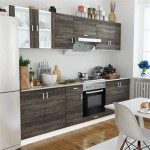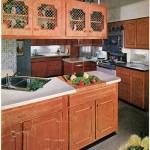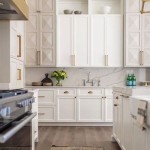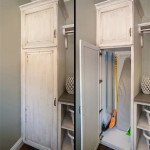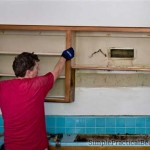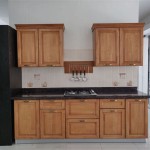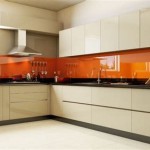Crown Molding: Elevate Your Kitchen Cabinet Tops
Transform the look of your kitchen with crown molding, an elegant trim that adds sophistication and character to cabinet tops. Crown molding not only enhances the aesthetic appeal but also conceals gaps and uneven surfaces, creating a seamless transition between cabinets and the ceiling.
Types of Crown Molding
Crown molding comes in various profiles, each with its unique shape and size. Popular choices include:
- Rounded Crown: With a soft, curved profile, rounded crown is a classic choice that blends well with traditional and contemporary kitchen styles.
- Cove Crown: Creates a dramatic accent with its concave profile. It adds a touch of elegance to both modern and traditional kitchens.
- Stepped Crown: Featuring multiple tiers of varying heights, stepped crown adds visual interest and depth to the tops of your kitchen cabinets.
- Dentil Crown: Intricate and elaborate, dentil crown features small, evenly spaced blocks or dentils along its edge.
Materials for Crown Molding
Crown molding is typically made from wood, MDF (medium-density fiberboard), or polyurethane. Each material has its advantages and disadvantages:
- Wood: The most traditional and durable option, wood crown molding exudes elegance and adds natural warmth to your kitchen. However, it requires more maintenance and can be expensive.
- MDF: A cost-effective alternative to wood, MDF is easy to work with and can be painted or stained to match your kitchen cabinets. It is less durable than wood but still offers a sturdy and stylish option.
- Polyurethane: Known for its water resistance and low maintenance, polyurethane crown molding is a practical choice for kitchens prone to moisture. It is also lightweight and easy to install.
Installation Considerations
Proper installation is crucial for a seamless and professional-looking finish. Here are some key considerations:
- Cutting the Molding: Use a miter saw to make precise 45-degree cuts at the ends of the molding. This creates the necessary angle for a clean miter joint.
- Joining the Molding: Apply wood glue to the mitered edges and press them together firmly. Use a nail gun or brad nailer to secure the joint.
- Attaching to Cabinets: Position the crown molding along the top edge of the cabinets and use a brad nailer to secure it. Countersink the nails for a flush finish.
- Filling Gaps: Fill any gaps or imperfections with wood filler or caulk. Sand the area smooth after it dries.
Finishing Touches
Once the crown molding is installed, consider adding a finishing touch to enhance its beauty and durability:
- Painting or Staining: Paint or stain the crown molding to match or complement your kitchen cabinets. Use a high-quality paint or stain designed for wood or MDF.
- Adding Glaze: Glaze can add depth and dimension to the crown molding. Apply a thin layer of glaze and wipe it off with a rag to create a subtle antiquing effect.
Maintenance
Regular maintenance will help your crown molding look its best for years to come. Clean it with a damp cloth and mild detergent to remove dust and dirt. If the molding is made of wood, apply a protective sealant or wax periodically to preserve its finish.

3 Ways To Enhance Your Kitchen With Crown Molding

Adding Crown Molding To Kitchen Cabinets Young House Love

11 Kitchen Cabinet Crown Molding Ideas For Your

Crown Molding For Shaker Kitchen Cabinets

3 Ways To Enhance Your Kitchen With Crown Molding

Diy Kitchen Cabinet Upgrade With Paint And Crown Molding

Crown Moulding The Recently Rediscovered Kitchen Solution

Adding Crown Molding To Kitchen Cabinets Young House Love

Decorative Molding Timberlake Cabinetry

Crown Molding Trim How It Enhances Your Space

